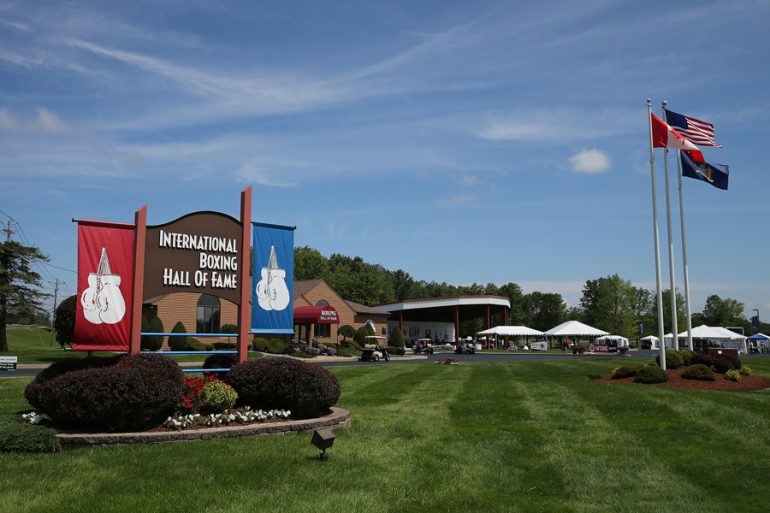The tidal wave of retirements and how it affects future IBHOF ballots

On August 3, former two-time heavyweight champion Wladimir Klitschko told the world via video and tweet that he was retiring from boxing. By doing so, he walked away from a contractually-mandated rematch with two-belt heavyweight titlist (and most recent conqueror) Anthony Joshua, as well as the eight-figure payday that would have come with it. While Klitschko’s decision surprised many, it was also hailed as an extension of Klitschko’s thoughtful and meticulous mindset and a rare example of a boxer leaving the sport with his bank account flush, his health intact and with his public regard – even in defeat – at its highest.
However, no one could have guessed that Klitschko’s act would trigger a mass exodus of high-profile names. Just one day later, Mexican legend Juan Manuel Marquez officially called it quits. Two-division titlist Timothy Bradley did the same, only a few hours later. Less than two weeks after that, three-division beltholder Shane Mosley hung up his gloves and the morning of August 27 brought two more retirement announcements – Floyd Mayweather Jr. following his TKO victory over mixed martial arts superstar Conor McGregor and Nathan Cleverly after his TKO loss to Badou Jack – and a threat to retire from former longtime WBC bantamweight king Shinsuke Yamanaka, should he not secure an immediate rematch with Luis Nery, who dethroned Yamanaka via fourth round TKO two weeks earlier.
Three other retirement announcements were made in late July by former 130-pound titlists Takashi Uchiyama and Takashi Miura as well as by Robert “The Ghost” Guerrero following recent defeats, but the most shocking exit was executed on September 21 by Andre Ward, the reigning pound-for-pound king and the holder of THE RING Magazine light heavyweight championship (as well as three sanctioning body belts).
“Mission accomplished,” Ward wrote on his website. “I want to be clear – I am leaving because my body can no longer put up with the rigors of the sport and therefore my desire to fight is no longer there. If I can’t give my family, my team and the fans everything that I have, then I should no longer be fighting.”
Finally, there is Miguel Cotto, who has repeatedly stated that 2017 will be his final year in boxing. Here’s something to ponder: What if Cotto makes good on his promise and what if he is joined by 48-year-old Roy Jones Jr. (who hasn’t fought since stopping Bobby Gunn last February) and by Manny Pacquiao (who will turn 39 in December and who may or may not get his rematch with Jeff Horn)? If they – along with Mayweather, Klitschko and Ward – retire and stay retired for the next five full years, they will create an unprecedented quandary for those who will assemble the International Boxing Hall of Fame’s Class of 2023 ballot – too many viable debutantes and not enough slots to make them all the first-ballot inductees they deserve to be. Even worse, there won’t be enough vacated slots from the Class of 2022 to include them all on the following year’s ballot.
Here’s why: Beginning with the 2006 class, the IBHOF reduced the number of Modern category inductees from four to three, meaning that three spots become available after every induction class. But if the worst-case scenario painted in the previous paragraphs actually happens, then there will be six fighters whose resumes scream “first-year, first-ballot inductee” – Mayweather, Jones, Ward, Pacquiao, Cotto and Klitschko – and half of them will be denied consideration from the voters because there won’t be enough spaces to even put them on the ballot, much less induct them. Even if the Hall allows a one-time expansion of available Modern ballot candidates from 30 to 35, voters are only allowed to choose a maximum of five names, which means one of the Stupendous Six will be denied a checkmark.
Yes, it’s an embarrassment of riches. But it also would be an embarrassment.
Granted, it’s very unlikely that the quagmire I suggested will occur but even if Jones, Pacquiao and Cotto continue to fight into 2018, the Class of 2023 would be set in stone – Mayweather, Ward and Klitschko. While that lineup will be one of the strongest and most meritorious three-man Modern classes in the Hall’s history, it also will remove any suspense from the voting process. After all, any voter who would deny these three one of the five maximum checkmarks should have his or her privileges revoked – and rightly so.
But this scenario touches on a problem that has been present since the three-man Modern Class was adopted for the Class of 2006 – worthy first-year eligibles crowding out others who have been on the ballot for several voting cycles. In the 12 classes since the new rules were instituted, four consisted entirely of first-year nominees (Roberto Duran, Ricardo Lopez and Pernell Whitaker in 2007, Julio Cesar Chavez, Mike Tyson and Kostya Tszyu in 2011, Joe Calzaghe, Oscar De La Hoya and Felix Trinidad in 2014 and Marco Antonio Barrera, Evander Holyfield and Johnny Tapia in 2017), while two more saw two first-year nominees get elected (Thomas Hearns and Mark “Too Sharp” Johnson in 2012, Arturo Gatti and Virgil Hill in 2013). Because of this, other worthy candidates such as Brian Mitchell, Jung Koo Chang, Yoko Gushiken, Hilario Zapata, Myung Woo Yuh, Lloyd Marshall, Cocoa Kid, Holman Williams, Naseem Hamed and Lupe Pintor languished much longer than their resumes warranted. They all ended up being enshrined but only during those years perceived to be weak, in terms of fresh names. A “soft year” shouldn’t be the only reason fighters such as these are immortalized but, as matters stand now, that is exactly why they finally broke through.
A look into the future suggests this glut will continue for years to come. Four big names will likely be considered for the first time ballot inclusion – Vitali Klitschko, Erik Morales, Ronald “Winky” Wright and Ricky Hatton – and it’s extremely probable that any combination of this quartet would be inducted next June (my guess: Klitschko, Morales and Hatton, though I would vote for Wright over “The Hitman,” if given that option), while the one aced out in 2018 probably will snag one of the three slots in 2019, a voting pool that could see the debuts of longtime titlists Chris John and/or Pongsaklek Wonjongkam along with Mikkel Kessler (if reports of a possible comeback don’t pan out) and little giant Ivan Calderon, if he doesn’t crack the ballot in the 2018 cycle, his first year of eligibility.
Because Marquez last fought in 2014, his first time before the voters will be during October 2019, the month when the Class of 2020 is considered. It’s a virtual guarantee that he and Sergio Martinez will lock down two of the three available Modern slots. Carl Froch will make his first appearance on that ballot and he may well earn spot number three. So that’s another class that could be penciled in years before the voting even starts.
Meanwhile, Mosley, who last fought in 2016, will join Bernard Hopkins as a Class of 2022 shoo-in and Bradley, another fighter whose last bout was in 2016, will vie with fellow first-time entrant Rafael Marquez to take the third slot.
Another significant part of the equation is that there are plenty of names that have been on the ballot for several years and whose candidacies are strong – Dariusz Michalczewski, Gilberto Roman, Wilfredo Vazquez Sr., Chris Eubank Sr., Nigel Benn, Sung Kil Moon, Julian Jackson, Orzubek Nazarov, Genaro Hernandez, Michael Moorer, Henry Maske, Gianfranco Rosi, Yuri Arbachakov, Sot Chitalada, Miguel Lora and Santos Laciar among them. But along with the cascade of first-year nominees who will arrive in the next few years, these fighters will be shoved even further away from enshrinement by those who will retire in the next several years such as Gennady Golovkin, Guillermo Rigondeaux, Sergey Kovalev, Roman Gonzalez, Nonito Donaire and Omar Narvaez. Then there are the younger guns who are on the path of reserving their own plaque such as Saul Alvarez, Terence Crawford, Vasyl Lomachenko, Mikey Garcia and Leo Santa Cruz.
Finally, what about fighters who have already been retired for the minimum five full years but have not yet made the ballot such as Veeraphol Sahaprom, Vuyani Bungu, Artur Grigorian, Masamori Tokuyama, Raul Perez, Marvin Johnson and Luis Estaba? Although each are deserving of a chance before the voters, the aforementioned circumstances virtually guarantee they will remain on the outside looking in. This should not be.
The point is there are plenty of candidates who can be placed before the voters and the supply will likely continue for the foreseeable future. Therefore, I believe IBHOF Executive Director Ed Brophy and his voting committee should consider the following reforms:
* Expanding the list of Modern ballot candidates from 30 to at least 35 (though I would prefer 40)
* If the 40-name list is adopted, allowing voters to place checkmarks on a maximum of 10 names instead of the current five (eight, if the 35-name list is approved)
* Restoring the four-man Modern induction class
While I believe the current protocol has fulfilled its mission of elevating the standard for enshrinement, there comes a point when strictures can become too suffocating, both for the nominees and for those charged with the responsibility of voting for them, of which I am one and have been since 2001. In my opinion, that point has been reached and the rush of retirements over the past few months illustrates how strongly reform is needed. Therefore, I believe it would behoove the Hall to revisit and revise. If they do so, the procession of new Hall-of-Famers will flow more easily but not so easily that it will negatively affect standards. That’s the balance that must be achieved and the only way to get it is to change the system – and soon.
*
Lee Groves is a boxing writer and historian based in Friendly, West Virginia. He is a full member of the BWAA, from which he has won 15 writing awards, including 12 in the last seven years and two first-place awards since 2011. He has been an elector for the International Boxing Hall of Fame since 2001 and is also a writer, researcher and punch-counter for CompuBox, Inc. He is the author of “Tales from the Vault: A Celebration of 100 Boxing Closet Classics (available on Amazon)” and the co-author of the upcoming book “Muhammad Ali: By the Numbers.” To contact Groves, use the email [email protected].
Struggling to locate a copy of THE RING Magazine? Try here or…
SUBSCRIBE
You can subscribe to the print and digital editions of THE RING Magazine by clicking the banner or here. You can also order the current issue, which is on newsstands, or back issues from our subscribe page. On the cover this month: Canelo-Golovkin
















